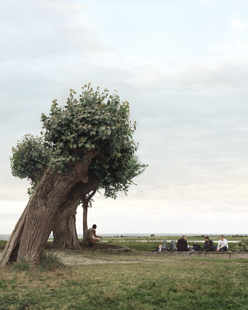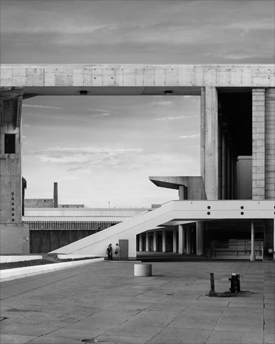Beate Gütschow: LS/S

About the Exhibition
Beate Gütschow’s exploration as an artist directly probes questions of pictorial representations of reality. As a student in Hamburg and Oslo, she explored verisimilitude initially as a painter and installation artist and eventually became attracted to photography for its apparent, though qualified, ability to more faithfully and accurately represent reality.
Her final constructions at first glace appear as if captured from reality but upon closer inspection they are revealed as fiction.
The exhibition surveys two of Gütschow’s photographic series: LS and S. LS is an abbreviation of Landschaft, or landscape, and S is for Stadt, or city. Both series posit questions of idealization—one of nature and the other of urbanity. Drawing from her enormous archive of collected images, mostly taken with analog film, of trees, buildings, clouds, hills and people, Gütschow’s pictures are montages consisting of up to hundred different images assembled together digitally. Her final constructions at first glace appear as if captured from reality but upon closer inspection they are revealed as fiction.
Influenced by artists such as Claude Lorrain, John Constable, and Nicolas Poussin, the LS series follows the rules of romantic landscape painting of the 17th century. Traditional landscape paintings are organized with three distinct spaces: the foreground serves as the viewer’s entrance into the picture, usually framed by trees like a stages set; the middle ground contains a river or path and people looking outward; and the background vanishes in the far distance. The frame suggests an expansive terrain. Using these rules, Gütschow creates an idyllic landscape by mixing elements of pictures taken from parks, construction sites, pristine nature, and people engaged in leisure activities. The deliberate inclusion of familiar 21st century elements like garbage, trees cut by chainsaws, and people in T-shirts endows an otherwise romantic landscape with implausibility and suspicion.
While the LS series recalls 17th century landscape painitng, the S series makes reference to more recent media—black-and-white architectural and documentary photography of the 1950s and ’60s. The LS series depicts an Arcadian state while the S series is post-apocalyptic, revealing failed social ideals through alienating architecture. Photographing in Berlin, Chicago, Kyoto, Los Angeles, New York, and Sarajevo, Gütschow appropriates buildings, parking lots, stairways, and people. Reconfiguring these elements of architecture from different areas of the world, she synthesizes a disorienting cosmopolitan space with a confused temporality. Just as she positions picnic-goers in her landscapes, her Gütschow recontextualizes the images of homeless people and tourists—fixtures of the modern city, That these displaced subjects seem hardly out of place in Gütschow’s S series reveals something about the cities in which they were photographed. Despite the utopian ideals behind the modern architecture, cities are less hospitable than we idealize them to be.
In spite of photography’s inherent ability to record facts, Gütschow creates a visual space that can be more readily accessed with the tools of fiction.
Gütschow’s process confers substantially more latitude for making ideas visual than photographers using analog film enjoy. The photographer’s ability to tell a story is constrained by the physical orientation of subjects in the focal field, but Gütschow starts like a painter with a blank canvas. She combines pictures from a variety of times and a wide range of geographical places while a traditional photographer is tied to the moment when, and the space where, the photograph is taken. In spite of photography’s inherent ability to record facts, Gütschow creates a visual space that can be more readily accessed with the tools of fiction.
In conjunction with the exhibition Beate Gütschow: LS/S the Museum of Contemporary Photography is collaborating with Aperture to release a monograph of the artist’s work in Fall 2007 comprised of her two most recent bodies of work.
Image Gallery

